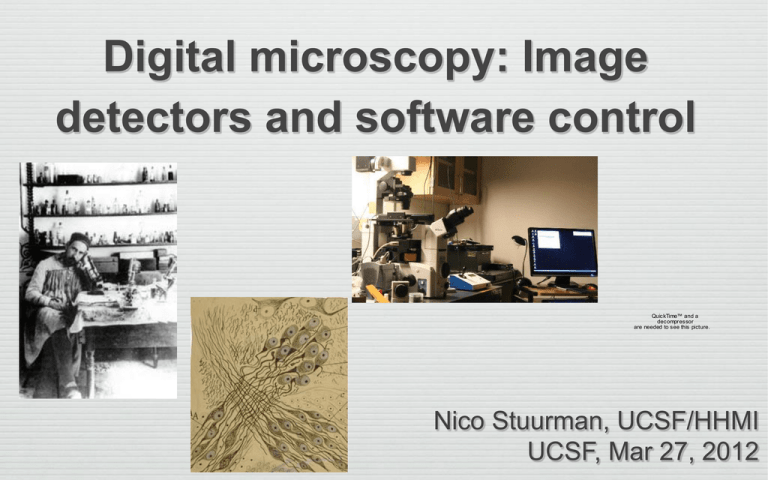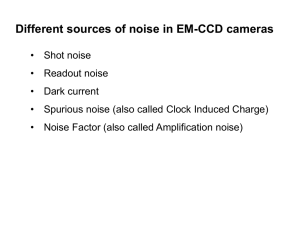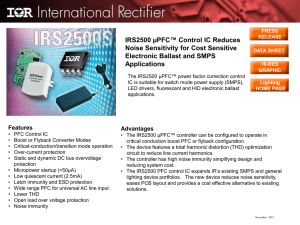UCSF_2012_03_detectors
advertisement

Digital microscopy: Image detectors and software control QuickTime™ and a decompressor are needed to see this picture. Nico Stuurman, UCSF/HHMI UCSF, Mar 27, 2012 Outline n Detectors: n n n ‘Single point’ detectors ‘Multiple point’ detector (cameras) Software control of image acquisition Imaging Detectors Photon -> Electrons -> Voltage ->Digital Number Single point detector Multi point detector (camera) Speed! Lens Detector V time 10 200 35 12 90 85 105 73 80 95 Camera Analogue Digital Converter (ADC) A->V->ADC 10 200 35 12 90 85 105 73 80 95 Photo-Multiplier Tube (PMT) • Very linear • Very High Gain • Fast response • Poor Quantum efficiency (~25%) PMT modes n Photon counting mode: n Count pulses n Zero background n Slow n Linear mode n Measure current n Fast but noisy Avalanche Photo Diode n Absorbed photons->electron n Electrons amplified by high voltage and ‘impact ionization’ n High QE (~90%) n Photon-counting ability (different design) n Overheats if run too fast Cameras in Microscopy Arrays of photo-sensitive elements … Two Architectures: Complementary Metal Oxide Semiconductor (CMOS) Each pixel has an amplifier Transfers voltage Fast Noisy Charged Coupled Devices (CCD) Single read-out amplifier Transfers charge Slow Precise CCD readout “bucket-brigade” analogy CCD Architecture Channel stops define columns of the image Plan View One pixel Three transparent horizontal electrodes define the pixels vertically. Transfer charge during readout Cross section Electrode Insulating oxide n-type silicon p-type silicon CCD Architecture Electrodes Insulating oxide n-type silicon p-type silicon incoming photons incoming photons 2 +5V 0V Charge Transfer in a CCD -5V 1 +5V 0V -5V +5V 3 0V -5V 1 2 3 Time-slice shown in diagram 2 +5V 0V Charge Transfer in a CCD -5V 1 +5V 0V -5V +5V 3 0V -5V 1 2 3 Time-slice shown in diagram 2 +5V 0V Charge Transfer in a CCD -5V 1 +5V 0V -5V +5V 3 0V -5V 1 2 3 Time-slice shown in diagram 2 +5V 0V Charge Transfer in a CCD -5V 1 +5V 0V -5V +5V 3 0V -5V 1 2 3 Time-slice shown in diagram 2 +5V 0V Charge Transfer in a CCD -5V 1 +5V 0V -5V +5V 3 0V -5V 1 2 3 Time-slice shown in diagram Charge Transfer in a CCD Transfer charge to the next pixel 2 +5V 0V -5V 1 +5V 0V -5V 3 1 2 3 Time-slice shown in diagram CCD Architectures Rare Mostly EMCCDs Common Full frame CCDs cannot acquire while being read out; They also require a mechanical shutter to prevent smearing during readout. Why don’t we use color CCDs? • Four monochrome pixels are required to measure one color pixel • Your 5MP digital camera really acquires a 1.25 MP red and blue image and a 2.5 MP green image and uses image processing to reconstruct the true color image at 5 MP Vital Statistics for CCDs • Pixel size and number • Quantum efficiency: fraction of photons hitting the CCD that are converted to photo-electrons • Full well depth: total number of photo-electrons that can be recorded per pixel • Read noise • Dark current (negligible for most biological applications) • Readout time (calculate from clock rate and array size) • Electron conversion factor (relate digital numbers to Pixel size and Resolution 1392 … … 1040 … … Sony Interline Chip ICX285 6.45 μm on a side Chip is 8.98 x 6.71 mm Typical magnification from sample to camera is roughly objective magnification, so 100x objective -> Resolution and magnification More pixels / resolution element Where is optimum? Digital Sampling • How many CCD pixels are needed to accurately reproduce the smallest object that can be resolved by the scope? •Nyquist-Shannon Sampling theorem: Must have at least two pixels per resolvable element •2.5 – 3 is preferable A resolution-centric view of imaging • Resolution is a function of the objective NA and wavelength (e.g. 1.4 NA with 500 nm light -> ~ 220 nm resolution) • To achieve this resolution, 220 nm in your image must cover 2 pixels • Choose your magnification to achieve this • • For 6.45 μm pixels, we need a total magnification of 6450/110 = 58.6 So for 1.4 NA, a 40x lens would be undersampled, a 60x would be just at the Nyquist limit, and a 100x lens would oversample Quantum Efficiency Back-thinning increases QE Noise n Longer exposure times are better – why? Decreasing exposure time Noise • Photon Shot Noise: Due to the fact that photons are particles and collected in integer numbers. Unavoidable! - Scales with √ of the number of photons • Read noise - inherent in reading out CCD - Faster -> Noisier - Independent of number of photons • Fixed Pattern Noise - Not all pixels respond equally! - Scales linearly with signal - Fix by flat-fielding • Dark current – thermal accumulation of electrons - Cooling helps, so negligible for most applications Signal/Noise Ratio (SNR) • Signal = # of photons = N • Noise = √ (read 2 noise + N) • When # of photons << read 2 noise -> Read noise dominates • When # of photons >> read 2 noise -> Shot noise dominates • When shot noise dominates (Signal/Noise = N/√ N), to double your SNR, you need to acquire four times as long (or 2x2 bin) Often, read-noise dominates 10 photons / pixel on average; ~50 in brightest areas Test image no read noise Photon shot noise ~ 3/5 read noise 5 e read noise Binning • Read out 4 pixels as one • Increases SNR by 2x • Decreases read time by 2 or 4x • Decreases resolution by 2x Beating the read-out noise EMCCD EMCCD result n n n n Fast noisy CCD – runs at 30 fps, but 50 e read noise Multiply signal by 100-fold – now read noise looks like 0.5 eDownside – multiplication process adds additional Poisson noise (looks like QE is halved) Upside – you get to image fast without worrying about read noise s(cientific)CMOS < 1.5 electron read-noise! •2,000 x 2,000 pixels, 6.5 micron •100 fps full frame, subregions up to 25,000 fps •fixed pattern noise •binning does not reduce r.o. noise •global versus rolling shutter Dynamic Range: How many intensity levels can you distinguish? • • • • Full well capacity (16 000 Readout noise: 5e- e) Dynamic range: – FWC/readout noise: 3200 – 0.9 * FWC / (3 * readout noise) = 960 (Human eye ~ 100) Bitdepth n n n n n n Digital cameras have a specified bitdepth = number of gray levels they can record 8-bit → 28 = 256 gray levels 10-bit → 210 = 1024 gray levels 12 12-bit → 2 = 4096 gray levels 14 14-bit → 2 = 16384 gray levels 16 16-bit → 2 = 65536 gray levels Photons and Numbers • Zero photons collected doesn’t result in number zero. Offset can often be changed • 1 photon does not necessarily equal 1 count in your image – electron conversion factor - depends on camera gain Measure the electron conversion factor: When the dominant noise source is Photon Shot noise: σ(N)= √(N) . N = c DN σ(N) = c σ(DN) . c= 2 DN/σ (DN) Photon Shot noise c = electron conversion factor Measure Photon Conversion Factor and full well capacity Photon Transfer Curve from: James R. Janesick, Photon Transfer, DN -> λ. SPIE Press, 2007 http://valelab.ucsf.edu/~MM/MMwiki/index.php/Measuring_camera_specifications Software control of microscopes: μManager as an example n Nico Stuurman, Arthur Edelstein, Ziah Dean, Henry Pinkard, Ron Vale. Dept. of Cellular and Molecular Pharmacology, UCSF/HHMI - San Francisco Why micro-manager.org? Started summer 2005 at Vale Lab, UCSF • Single Interface for all microscopes • Standard and open plug-in interface • Choice in hardware • (Real) extensibility • Quality • Cost μManager features • Simple user interface to important imaging strategies: Snap Image, Time-lapse, z-series, multi-channel, multi-positions • Controls many microscope hardware components • Hardware support can be added by anyone • Integrated with ImageJ • Cross-platform (Windows, Mac, Linux) • Open Source • Modular architecture: Extensible by third parties: at hardware support level and User Interface • Powerful scripting interface • Programmatic interfaces to 3rd-party analysis environments such as Matlab enabling analysis driven acquisition • Free! Supported Hardware n Microscopes:Nikon: TE2000, TI, AZ100 nZeiss: AxioPlan, AxioVert, AxioObserver, AxioImager nLeica: most motorized scopes nOlympus n IX81, BX81 Cameras: nAndor nABSCamera nHamamatsu nRoper/Photometrics nQImaging Mad City Labs Maerzhauser Physik Instrumente Communication ports, IO: Serial, parallel, USB port DTOpenlayer Velleman K8055 and K8061 National Instruments Other devices: Neos AOTF controller Spectral LMM5 Yokogawa CSU22 and CSUX Pecon environmental control See: http://micro-manager.org Support and Statistics Website: http://micro-manager.org Wiki: http://valelab.ucsf.edu/~nico/MMwiki Source code: https://valelab.ucsf.edu/svn/micromanager2/branches/micromanager1 .4 Mailing list: https://lists.sourceforge.net/lists/listinfo/micro-managergeneral Support/Help: info@micro-manager.org 10,000 registered users (~250 new users every month) 600 subscribers to the mailing list Thanks! n Kurt Thorn (UCSF Nikon Imaging Center) n http://micro.magnet.fsu.edu n James Pawley, Handbook of Biological Confocal Microscopy n James R. Janesick, Photon Transfer, DN -> λ. SPIE Press, 2007 File Formats n Most portable: TIFF –8 n or 16-bit, lossless, supports grayscale and RGB OK: JPEG2000, custom formats (nd2, ids, zvi, lsm, etc.) – Lossless, – Custom – Not n supports full bitdepth formats often support multidimensional images so portable Bad: Jpeg, GIF, BMP, etc. – Lossy and / or 8-bit (Linear) digital filters n Kernels 1 1 1 1 1 1 1 1 1 Averaging / Smoothing 0 1 2 1 0 1 6 10 6 1 2 10 16 10 2 1 6 10 6 1 0 1 2 1 0 Gaussian smoothing How this works 1 1 1 Multiply corresponding pixels and sum 1 1 1 1 1 1 10 11 22 5 7 13 14 8 10 5 24 20 20 15 23 14 0 3 17 15 8 7 11 6 15 12 (10+11+22+13+8+10+20+20+15)/9 = 14 Example: Unsharp masking Original Unsharp masked -1 -4 -1 -4 2 -4 6 Increasing energy Photo-electric Effect Conduction Band 1.26eV Valence Band Hole Electron What does this look like? Test image 1000 ph/pixel, no read noise Photon shot noise = 6x read noise 1000 ph/pixel, 5 e read noise What does this look like? Test image 100 ph/pixel, no read noise Photon shot noise = 2x read noise 100 ph/pixel, 5 e read noise Beating the read-out noise Intensified CCD (ICCD) Signal/Noise Ratio (SNR) n Read noise dominates whenever read noise2 >= # of photons 8 e- read noise → 64 photons n 16 e- read noise → 256 photons n 50 e- read noise → 2500 photons n n Full range on Coolsnap HQ2 with 4x gain: 4095 photons Read-noise Test image 10 ph/pixel, no read noise 10 ph/pixel, 5 e read noise Photon shot noise = 1/3 x read noise






